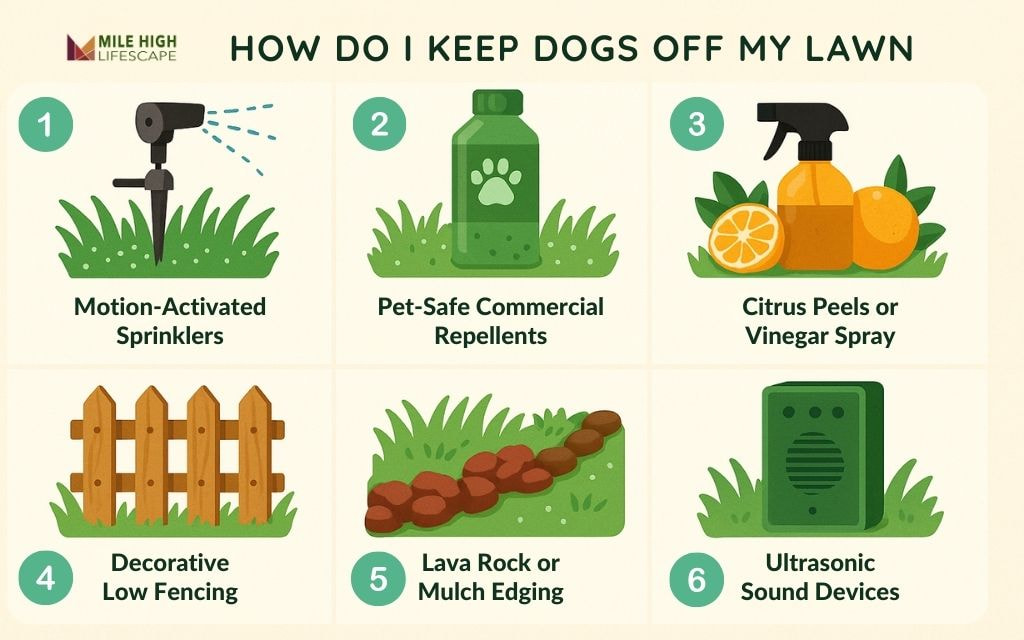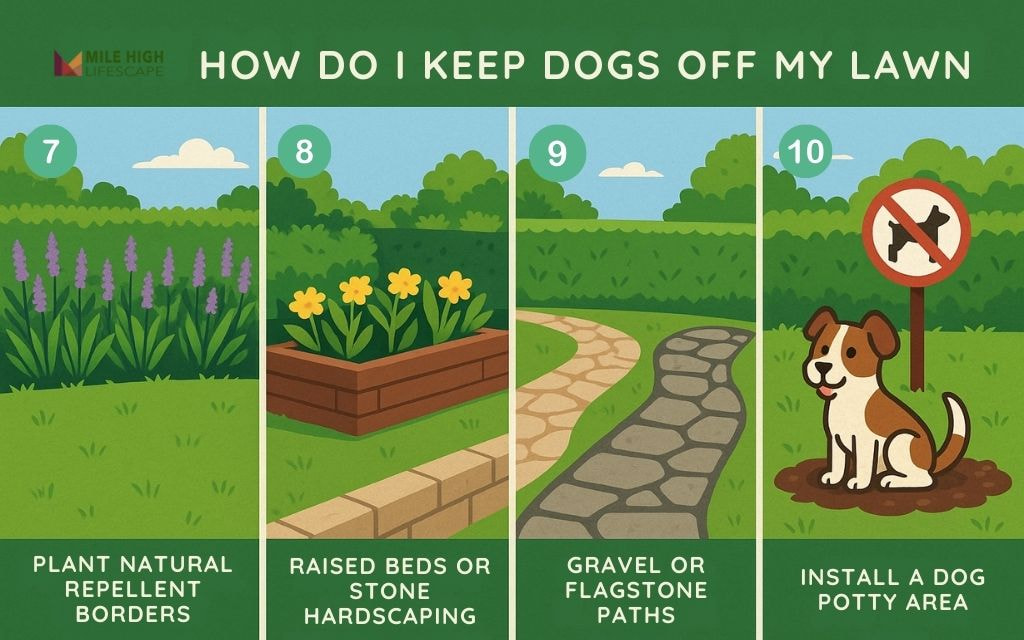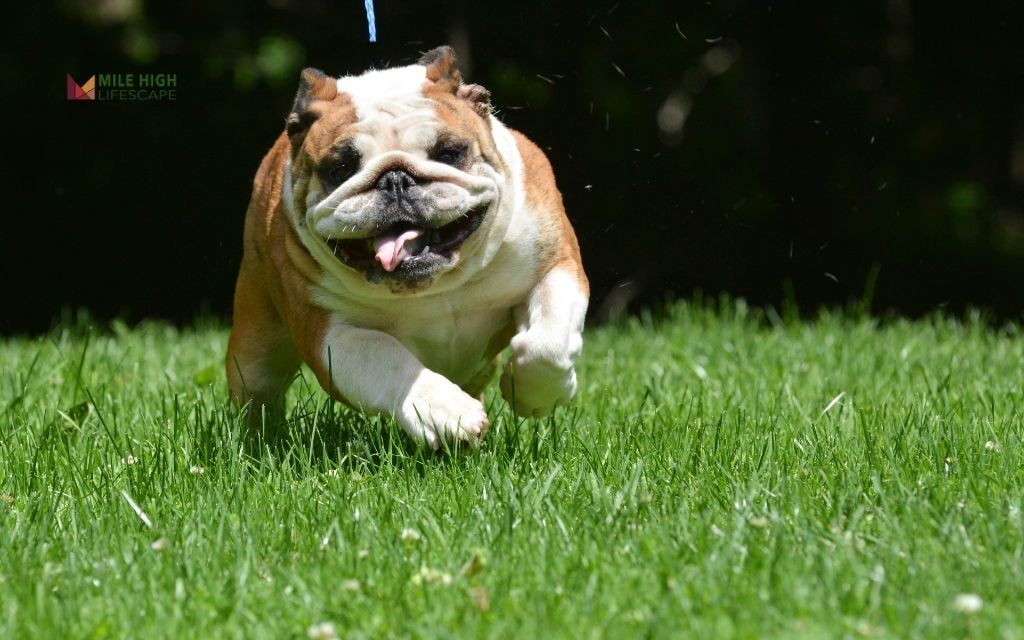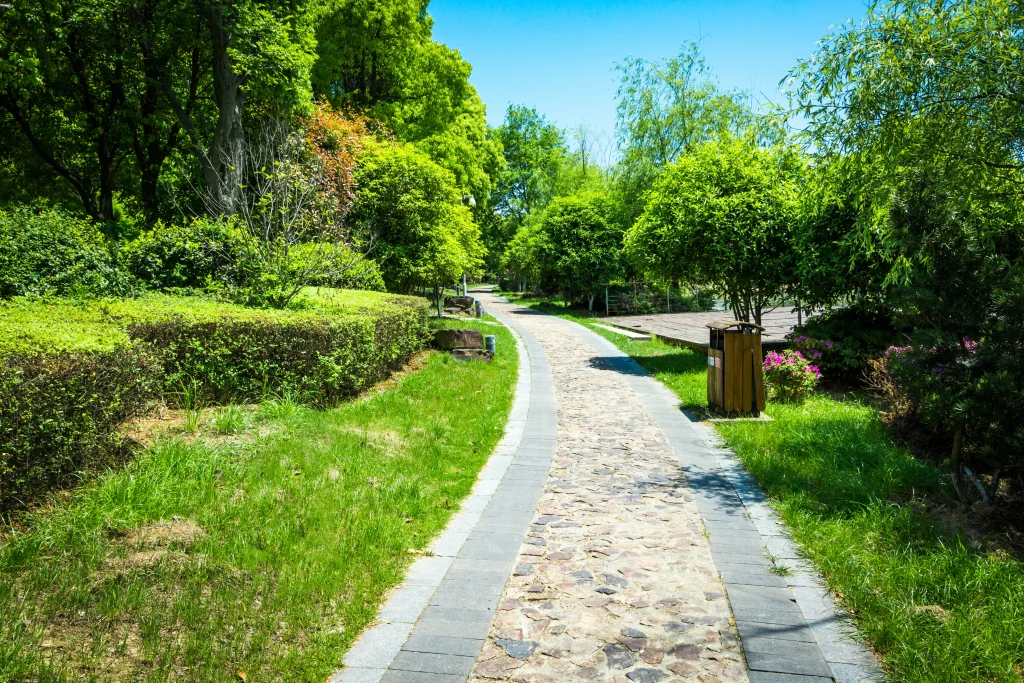How do i keep dogs of my lawn? To effectively keep dogs off your lawn, consider a combination of methods like installing physical barriers, using motion-activated deterrents, applying natural repellents, and implementing strategic landscaping solutions.
Denver homeowners invest time and resources into maintaining healthy lawns despite our challenging climate. When neighborhood dogs or even your own pets damage that investment, frustration follows quickly. Dog traffic creates worn paths, while urine burns grass with concentrated nitrogen that leaves unsightly yellow or brown patches.
This challenge requires thoughtful solutions that respect both your property rights and animal welfare. This guide provides humane, practical solutions whether you’re a dog owner or simply want to protect your lawn from neighborhood pets.
How Do I Keep Dogs Off My Lawn: Top 10 Strategies That Work
#1: Motion-Activated Sprinklers
These clever devices combine a motion sensor with a quick burst of water, startling dogs (and other animals) without causing harm. They’re particularly effective in open front yards where dogs may wander freely.
The surprise factor teaches animals to avoid your lawn without any negative associations with you or your property.
Many Denver homeowners find these are water-efficient despite our restrictions, as they activate only when needed and use minimal water per spray.
#2: Pet-Safe Commercial Repellents
These products typically use scents that dogs find unpleasant but are completely safe and often contain essential oils like citronella, eucalyptus, or pepper derivatives.
Remember that Denver’s summer afternoon thunderstorms can wash away repellents, so reapplication is necessary, especially during monsoon season (July-August).
#3: Citrus Peels or Vinegar Spray
Dogs typically avoid citrus scents. Place lemon or orange peels around your lawn’s perimeter or create a simple spray with one part white vinegar to three parts water.
Test this solution on a small grass patch first, as Denver’s native grasses and ornamental varieties respond differently to acidic solutions.
#4: Decorative Low Fencing
Even minimal physical barriers can make a significant difference. A decorative border fence just 1-2 feet high signals a boundary to both dogs and their owners without making your yard feel closed off.
Choose wrought iron or period-appropriate wooden options that maintain your home’s character while protecting your turf. Many garden shops offer metal edging that serves this purpose while complementing your landscaping.
#5: Lava Rock or Mulch Edging
Creating a barrier of materials dogs find uncomfortable to walk on can effectively keep them from entering your lawn area. Lava rock, small river stones, or pine bark mulch create a natural-looking border that most dogs prefer to avoid.
These materials work well with xeriscape-friendly landscaping trends and help with water conservation by reducing the grass area that needs irrigation.
The rough texture is unpleasant for sensitive paws but doesn’t cause any actual harm.
#6: Ultrasonic Sound Devices
These devices emit high-frequency sounds detectable only by dogs when they approach your property. Humans cannot hear these sounds, making them unobtrusive for your household while effectively discouraging canine visitors. Position multiple units for comprehensive coverage of larger Denver properties.

#7: Plant Natural Repellent Borders
Consider creating borders with rosemary, rue, or marigolds – all of which thrive in Denver’s sunny, dry conditions. These plants not only deter dogs but also add visual appeal and can withstand Colorado’s challenging growing conditions.
Thorny plants like barberry can create physical deterrents, though they should be placed thoughtfully to avoid creating hazards for people.
#8: Raised Beds or Stone Hardscaping
Strategic placement of raised planters or decorative boulders creates natural barriers at lawn corners and entry points commonly used by dogs. These landscape features redirect traffic patterns while enhancing your property’s aesthetic appeal and providing definition to your outdoor spaces.
#9: Gravel or Flagstone Paths
Many dog issues occur along established paths where they habitually travel. Installing proper pathways with materials like crushed granite, decomposed granite or flagstone can redirect both human and canine traffic while protecting vulnerable grass areas.
This approach works particularly well for side yards and areas between properties where dogs often create “runways.”
#10: Install a Dog Potty Area
If you’re a dog owner yourself, create a designated bathroom area using materials like pea gravel, mulch, or artificial turf in a side yard or back corner.
Train your dog to use only this space through positive reinforcement. This strategy has become increasingly popular in Denver neighborhoods with smaller yards where lawn space is at a premium.
A properly designed dog relief area can blend seamlessly with your landscaping while protecting the rest of your turf from nitrogen burns and wear patterns.

Why Dogs Are Attracted to Your Lawn
Understanding what draws dogs to your property helps implement effective deterrents. Dogs gravitate to lawns for several specific reasons:
- Soft grass provides comfortable walking and resting surfaces
- Fresh mulch contains appealing organic scents
- Lawn fertilizers often incorporate animal byproducts that attract dogs
- Previous marking creates a scent that encourages repeat visits
- Open lawns without visual boundaries appear as public territory to dogs
- Unneutered males instinctively mark territory through frequent urination
Denver’s community-oriented neighborhoods with limited physical barriers between properties inadvertently encourage dogs to explore beyond their boundaries.
Dog Damage: Why You Should Keep Dogs Off Your Lawn?
The impact of dog activity on your lawn goes beyond mere aesthetics. Denver’s unique growing conditions – including our challenging clay soils, high altitude sunlight intensity, and watering restrictions – make our lawns particularly vulnerable to damage.
Urine Burn
Dog urine contains high nitrogen concentrations that create the characteristic yellow spots with green rings on lawns.
While nitrogen is a fertilizer in small amounts, concentrated deposits essentially “over-fertilize” grass to death. This effect is more pronounced in Denver’s sunny, dry climate where lawns are already stressed.
Physical Damage
Dogs naturally create paths along fences or property lines through repeated use. This compacts soil, making it difficult for grass to receive water, oxygen, and nutrients.
Our clay-heavy Front Range soils are particularly susceptible to compaction issues, which can persist long after the dog traffic stops.
Digging Behavior
Dogs dig for various reasons – to create cooling depressions in summer, pursue burrowing animals, or out of boredom. Each hole disrupts your lawn’s root system and irrigation patterns, creating opportunities for weed establishment and further degradation.
Long-Term Effects
Under Denver’s watering restrictions, damaged areas recover more slowly than in wetter climates. What might be a temporary issue elsewhere can become a season-long eyesore here.
Additionally, damaged areas are more susceptible to weed invasion, especially from drought-tolerant weeds that thrive in disturbed soil.

Train Your Dog to Stay Off Certain Areas of the Lawn
Dog owners can implement training strategies to protect specific lawn areas:
- Designate a specific potty zone using distinct materials like gravel or mulch
- Initially use leash guidance to establish boundaries
- Mark protected areas with temporary flags or stones during training
- Provide immediate positive reinforcement when your dog uses the designated area
- Maintain consistent rules to establish clear patterns
- Practice multiple short training sessions rather than occasional long ones
- Gradually remove visual markers as your dog learns boundaries
This approach respects your pet’s needs while protecting your landscape investment.
Alternatives to Grass That Are More Pet-Resistant
For properties with persistent dog traffic, consider these alternatives to traditional lawns:
| Option | Pros | Notes for Denver |
| Artificial Turf | Durable, eliminates mud, requires no mowing or watering | Can overheat in Denver’s intense summer sun; install with proper drainage |
| Creeping Thyme | Drought-tolerant, releases pleasant aroma when walked on | Needs protection during establishment; thrives in Denver’s climate |
| Mulch or Gravel Paths | Reduces concentrated foot traffic on grass areas | May shift during heavy rainfall; choose heavier materials for stability |
| Flagstone Pavers | Long-lasting, creates defined walkways | Combine with drought-resistant plants; maintains temperature stability |
| Clover Lawn | More resistant to urine damage, requires less water | Establishes quickly in Denver’s growing season; stays green with minimal care |
Conclusion
Protecting your lawn from dog damage requires a multifaceted approach combining deterrents, training, and strategic landscaping. The most effective solutions balance your property maintenance goals with respect for pets and neighbors.
Start with the least invasive methods before progressing to more substantial interventions. Community communication often resolves issues before they require physical deterrents. For persistent problems, combining several strategies typically produces the best results.
For professional assistance with dog-friendly landscape design, turf replacement, or barrier installation specific to Denver’s unique conditions, contact Mile High Lifescape. Our team understands the local challenges and can implement solutions that protect your lawn while maintaining neighborhood harmony.
Frequently Asked Questions (FAQs)
How do I keep my neighbor’s dogs out of my yard?
To effectively keep neighbor’s dogs out of your yard, start with a friendly conversation about your concerns. If issues persist, install physical barriers like decorative fencing or motion-activated sprinklers. Document any damage if needed for HOA or municipal discussions.
What is the most effective dog repellent for lawns?
Motion-activated sprinklers provide the most consistent deterrent effect without harming your lawn or dogs. These devices respond to movement with a startling but harmless spray that discourages repeat visits without chemical application.
What scent will keep dogs away?
Several scents can deter dogs, including citrus, vinegar, ammonia, and certain essential oils like eucalyptus or citronella. Commercial products containing these scents offer standardized application methods, while household alternatives provide budget-friendly options.
How do I stop dogs pooping on my grass?
Create physical barriers at common entry points, apply commercial repellents to perimeter areas, and introduce landscape elements dogs avoid walking across. For community spaces, consider installing dog waste stations with complimentary bags to encourage responsible cleanup.
What is the best homemade dog repellent?
A good homemade dog repellent can be made using citrus peels soaked in water overnight or a spray combining vinegar, water, and a few drops of citrus essential oil. Apply these solutions to lawn borders weekly, especially after rainfall, for maximum effectiveness.
